
Chinese philosophy originates in the Spring and Autumn period (春秋) and Warring States period (戰國時期), during a period known as the "Hundred Schools of Thought", which was characterized by significant intellectual and cultural developments. Although much of Chinese philosophy begun in the Warring States period, elements of Chinese philosophy have existed for several thousand years. Some can be found in the I Ching, an ancient compendium of divination, which dates back to at least 672 BCE. It was during the Warring States era that what Sima Tan termed the major philosophical schools of China—Confucianism, Legalism, and Taoism—arose, along with philosophies that later fell into obscurity, like Agriculturalism, Mohism, Chinese Naturalism, and the Logicians. Even in modern society, Confucianism is still the creed of etiquette for Chinese society.

The Tao Te Ching is a Chinese classic text written around 400 BC and traditionally credited to the sage Laozi. The text's authorship, date of composition and date of compilation are debated. The oldest excavated portion dates back to the late 4th century BC, but modern scholarship dates other parts of the text as having been written—or at least compiled—later than the earliest portions of the Zhuangzi.

Taoism or Daoism refers to either a school of philosophical thought or to a religion ; both share ideas and concepts of Chinese origin and emphasize living in harmony with the Tao. The Tao Te Ching, a book containing teachings attributed to Laozi (老子), together with the later writings of Zhuangzi, are both widely considered the keystone works of Taoism.
Tao or Dao is the natural order of the universe, whose character, one's intuition must discern to realize the potential for individual wisdom, as conceived in the context of East Asian philosophy, East Asian religions, or any other philosophy or religion that aligns to this principle. This intuitive knowing of life cannot be grasped as a concept. Rather, it is known through actual living experience of one's everyday being. Its name, Tao or Dao(Chinese ), came from Chinese, where it signifies the way, path, route, road, or sometimes more loosely doctrine, principle, or holistic belief.

Laozi, also rendered as Lao Tzu, or Lao-Tze, proper name Li Er, courtesy name Boyang, was an ancient Chinese philosopher and writer. He is the reputed author of the Tao Te Ching, the founder of philosophical Taoism, and a deity in religious Taoism and traditional Chinese religions.

Zhuang Zhou, commonly known as Zhuangzi, was an influential Chinese philosopher who lived around the 4th century BCE during the Warring States period, a period of great development in Chinese philosophy, the Hundred Schools of Thought. He is credited with writing—in part or in whole—a work known by his name, the Zhuangzi, which is one of the foundational texts of Taoism.
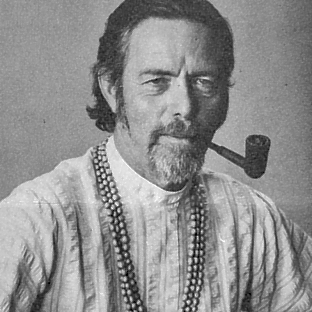
Alan Wilson Watts was an English writer, speaker and self-styled "philosophical entertainer", known for interpreting and popularising Japanese, Chinese and Indian traditions of Buddhist, Taoist, and Hindu philosophy for a Western audience. Born in Chislehurst, England, he moved to the United States in 1938 and began Zen training in New York. He received a master's degree in theology from Seabury-Western Theological Seminary and became an Episcopal priest in 1945. He left the ministry in 1950 and moved to California, where he joined the faculty of the American Academy of Asian Studies.
The School of Names, sometimes called the School of Forms and Names, was a school of Chinese philosophy that grew out of Mohism during the Warring States period in 479–221 BCE. The followers of the School of Names were sometimes called the Logicians or Disputers.

The Han Feizi is an ancient Chinese text attributed to foundational political philosopher, "Master" (zi) Han Fei. It comprises a selection of essays in the Legalist tradition on theories of state power, synthesizing the methodologies of his predecessors. Its 55 chapters, most of which date to the Warring States period mid-3rd century BC, are the only such text to survive intact.

Wu wei is an ancient Chinese concept literally meaning "inexertion", "inaction", or "effortless action". Wu wei emerged in the Spring and Autumn period, and from Confucianism, to become an important concept in Chinese statecraft and Taoism. It was most commonly used to refer to an ideal form of government, including the behavior of the emperor. Describing a state of unconflicting personal harmony, free-flowing spontaneity and savoir-faire, it generally also more properly denotes a state of spirit or mind, and in Confucianism accords with conventional morality.
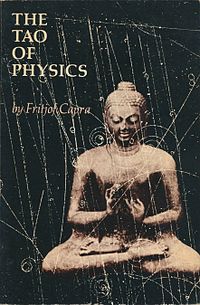
The Tao of Physics: An Exploration of the Parallels Between Modern Physics and Eastern Mysticism is a 1975 book by physicist Fritjof Capra. A bestseller in the United States, it has been translated into 23 languages. Capra summarized his motivation for writing the book: “Science does not need mysticism and mysticism does not need science. But man needs both.”

The Eastern religions are the religions which originated in East, South and Southeast Asia and thus have dissimilarities with Western, African and Iranian religions. This includes the East Asian religions such as Confucianism, Taoism, Shenism, Shintoism, and Sindoism, South Asian religions including Indian religions such as Hinduism, Buddhism, Sikhism, and Jainism, and Southeast Asian religions such as Vietnamese folk religion and Caodaism as well as animistic indigenous religions.
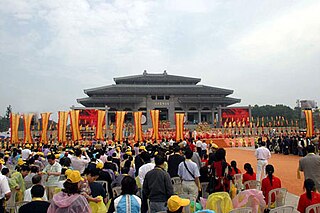
In the study of comparative religion, the East Asian religions or Taoic religions, form a subset of the Eastern religions. This group includes Chinese religion overall, which further includes Ancestral Worship, Chinese folk religion, Confucianism, Taoism and popular salvationist organisations, as well as elements drawn from Mahayana Buddhism that form the core of Chinese and East Asian Buddhism at large. The group also includes Japanese Shintoism, and Korean Muism, all of which combine Shamanistic elements and indigenous ancestral worship with various influences from Chinese religions. Chinese salvationist religions have influenced the rise of Japanese new religions such Tenriism and Korean Jeungsanism; as these new religious movements draw upon indigenous traditions but are heavily influenced by Chinese philosophy and theology.
The history ofTaoism stretches throughout Chinese history. Originating in prehistoric China, it has exerted a powerful influence over Chinese culture throughout the ages. Taoism evolved in response to changing times, with its doctrine and associated practices being revised and refined. The acceptance of Taoism by the ruling class has waxed and waned, alternately enjoying periods of favor and rejection. Most recently, Taoism has emerged from a period of suppression and is undergoing a revival in China.
Chungliang “Al” Huang is a notable philosopher, dancer, performing artist, and internationally acclaimed taijiquan master and educator, having received the Republic of China’s most prestigious award in the field of education, the Gold Medal Award, from its Ministry of Education.
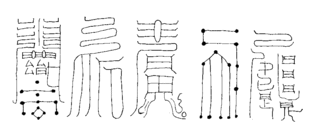
The Baopuzi is a literary work written by Ge Hong 葛洪 (283–343), a scholar during the turbulent Jin dynasty. Baopuzi is divided into two main sections, the esoteric Neipian 內篇 "Inner Chapters" and equally exoteric Waipian 外篇 "Outer Chapters". The Taoist Inner Chapters discuss topics such as techniques to achieve "hsien" 仙, Chinese alchemy, elixirs, and demonology. The Confucian Outer Chapters discuss Chinese literature, Legalism, politics, and society.
Huang–Lao or Huanglao was the most influential Chinese school of thought in the early 2nd-century BCE Han dynasty, having its origins in a broader political-philosophical drive looking for solutions to strengthen the feudal order as depicted in Zhou propaganda. Not systematically explained by historiographer Sima Qian, it is generally interpreted as a school of syncretism, developing into a major religion, the beginnings of religious Taoism.
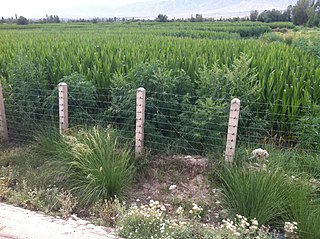
Cannabis in China is illegal except for industrial purposes (hemp) and some forms of medicine. Historically, cannabis has been used in China for fiber, seeds, as a traditional medicine, as well as for some ritual purposes within Taoism.

Yang Xi, courtesy name Xihe, was an Eastern Jin dynasty scholar, calligrapher, and mystic, who is best known for the "Shangqing revelations" that were purportedly dictated to him by Taoist deities between 364 and 370. The Taoist polymath Tao Hongjing subsequently compiled and redacted Yang's revealed texts into the c. 499 Zhen'gao compendium, which formed the foundations of the Shangqing School of Taoism.
Taoist philosophy also known as Taology refers to the various philosophical currents of Taoism, a tradition of Chinese origin which emphasizes living in harmony with the Dào. The Dào is a mysterious and deep principle that is the source, pattern and substance of the entire universe.














